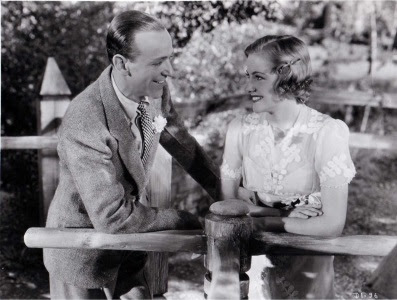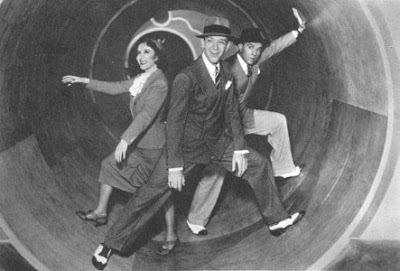A Damsel in Distress

Director: George Stevens
Year: 1937
Rating: 5.5
After seven straight films co-starring with Ginger
Rogers, Fred Astaire took on another leading lady for the first time and
it was to be the first to lose money. He went back to Rogers for two more
films right after this. Not that it would have made much sense to have Rogers
in this one as the role in question is that of a daughter of an English Lord.
With her flat American accent that would have been tough but the easy-going
romantic plot certainly would have fit in with the other Astaire-Rogers films.
Director George Stevens chooses a newcomer - Joan Fontaine which seems an
odd choice. Not that she isn't a wonderful actress and there are a few close-ups
that are Hollywood magic. But she can't dance a lick or sing I expect as
they don't give her the chance to do so. She is only in one musical number
- Things are Looking Up - and she basically alternates between walking and
skipping as Astaire dances around her. When they realized she couldn't dance,
Astaire wanted to get Ruby Keeler which might have been interesting though
seeing her play an English Lady stretches the imagination.

The music for the most part comes from two
of the greatest Tin Pan Alley composers ever - George and Ira Gershwin. There
are two classics - A Foggy Day in London Town and Nice Work If You Can Get
It - and a few other solid songs. Tragically, George Gershwin was to die
of a brain tumor before the film was released. The real disappointment in
the film for me is the dance choreography which feels uninspired except for
one number. Hermes Pan who choreographed all nine of the Astaire-Rogers films
is in charge here but none of them click. The great A Foggy Day in London
Town takes place in a forest. Huh? And Nice Work if You Can Get It is sung
by three elderly women and Astaire is barely in it. There is one lengthy
number in a Fun House with Astaire and Burns and Allen that is very clever
but even then the dancing is minimum. The film ends with Astaire playing
the drums - with his feet - all in one take and it is pretty amazing.

Yup, George Burns and Gracie Allen. They
play his agent and his secretary - George the straight man to Gracie's head
swirling dizziness and malapropisms that rat-a-tat so quickly that I missed
many of them.
(George) "What's today?"
(Gracie Allen) "Oh,
I don't know."
(George Burns) "Well,
you can tell if you look at that newspaper on your desk."
(Gracie Allen) "Oh,
this is no help, George. It's yesterday's paper."
(Gracie Allen) "You
know, if it weren't for two things you'd be a terrific dancer."
(George Burns) "What's
that?"
(Gracie Allen) "Your
feet."
I adore Gracie Allen. Interestingly, when
they first started their act Gracie was the straight man but even as the
straight woman she got more laughs than George, so he switched them around.
The film is a puff of merry clouds. Fred
is a famous song and dance man in London when Joan jumps into his cab to
escape a manservant following her to keep her out of trouble. She is in love
with an American and her family disapproves. A cupid makes Astaire believe
that she has fallen in love with him and so goes after her to the Castle
she lives in. Many misunderstandings later the expected happens. Lots of
space is given to Reginald Gardiner as the opera loving manservant, Montague
Love as the perplexed Lord and Harry Watson as the mischievous cupid - all
well done. Not one of Astaire's best - it has no buzz but Astaire is always
charming. "Say goodnight, Gracie", "Goodnight Gracie".





